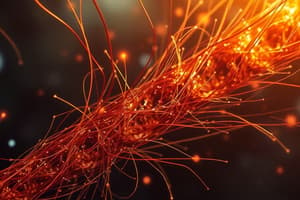Podcast
Questions and Answers
Why are fibers considered class evidence?
Why are fibers considered class evidence?
They are mass-produced
Where can fibers come from?
Where can fibers come from?
Clothing, coats, carpet, furniture, curtains, bedding, insulation, rope
What is direct transfer?
What is direct transfer?
The passing of evidence from victim to suspect or vice versa
What is secondary transfer?
What is secondary transfer?
What percentage of fibers is lost after 24 hours?
What percentage of fibers is lost after 24 hours?
When using fibers as evidence, what do forensic scientists want to determine?
When using fibers as evidence, what do forensic scientists want to determine?
What is the type of fiber that indicates composition and uniqueness?
What is the type of fiber that indicates composition and uniqueness?
How can fiber color help in forensic investigations?
How can fiber color help in forensic investigations?
What does a higher number of fibers found suggest?
What does a higher number of fibers found suggest?
What is the first method of fiber collection?
What is the first method of fiber collection?
What is the fiber produced from rabbit hair?
What is the fiber produced from rabbit hair?
What is the tight lengthwise yarn in a weave pattern?
What is the tight lengthwise yarn in a weave pattern?
What macromolecule are animal fibers made out of?
What macromolecule are animal fibers made out of?
What are the fibers that are produced from a raw material such as coal and wood pulp that is spun together in a factory?
What are the fibers that are produced from a raw material such as coal and wood pulp that is spun together in a factory?
Which carbohydrate are plant fibers?
Which carbohydrate are plant fibers?
What are envelopes and paper made from?
What are envelopes and paper made from?
What are the classifications of fibers?
What are the classifications of fibers?
List 6 types of hair.
List 6 types of hair.
What are fibers?
What are fibers?
What is thread count?
What is thread count?
Name 3 natural fibers.
Name 3 natural fibers.
What is a good alternative to rayon because it is less polluting?
What is a good alternative to rayon because it is less polluting?
What is an inexpensive synthetic fiber that tends to ball easily?
What is an inexpensive synthetic fiber that tends to ball easily?
What is the most durable man-made fabric that is extremely lightweight?
What is the most durable man-made fabric that is extremely lightweight?
What is a lightweight but warm, soft, and resilient fabric?
What is a lightweight but warm, soft, and resilient fabric?
What is the first man-made fiber and also the most common synthetic fiber?
What is the first man-made fiber and also the most common synthetic fiber?
What are fibers made from cellulose esters derived from cellulose then modified?
What are fibers made from cellulose esters derived from cellulose then modified?
What fiber has extreme elastic properties?
What fiber has extreme elastic properties?
What are fibers that are totally man-made from petroleum plastics?
What are fibers that are totally man-made from petroleum plastics?
List 2 mineral fibers.
List 2 mineral fibers.
What are the four patterns of medulla?
What are the four patterns of medulla?
Why is asbestos used?
Why is asbestos used?
What is sisal?
What is sisal?
Where is sisal found?
Where is sisal found?
What is hemp?
What is hemp?
Where is hemp found?
Where is hemp found?
Flashcards are hidden until you start studying
Study Notes
Fiber Evidence Overview
- Fibers are considered class evidence due to mass production, making it difficult to link a specific fiber to a unique source.
- Common sources of fibers include clothing, carpets, furniture, curtains, bedding, insulation, and ropes.
Types of Fiber Transfer
- Direct Transfer: Evidence is passed from victim to suspect or vice versa.
- Secondary Transfer: Evidence is transferred from a source to a person (suspect) and then to another person (victim).
Fiber Loss and Forensic Analysis
- Approximately 95% of fibers can be lost within 24 hours after a crime.
- Forensic scientists aim to identify the type of fiber, its color, and the number of fibers found during investigations.
Characteristics of Fibers
- Type of Fiber: Determined by composition and uniqueness.
- Color: Aids in determining location or dyes used during production.
- Number of Fibers: A higher count may indicate a more violent crime or prolonged contact.
Methods of Fiber Collection
- The first method employed for fiber collection is a visual search.
Types of Fibers and Their Composition
- Animal Fibers: Made of protein (e.g., Angora from rabbit hair).
- Plant Fibers: Composed of cellulose (e.g., sisal used for ropes).
- Synthetic Fibers: Result from processes involving raw materials like coal and wood, including fibers such as nylon and polyester.
Fiber Classifications and Properties
- Fibers are classified as follows: Fiber → Yarn → Textile.
- Thread count refers to the number of threads per unit area in fabric, commonly noted for bed sheets.
Types of Natural and Synthetic Fibers
- Natural Fibers: Derived from animals (e.g., wool), plants (e.g., cotton, hemp), and minerals (e.g., asbestos, fiberglass).
- Synthetic Fibers: Include man-made materials like rayon, nylon, polyester, and spandex.
- Rayon is the first and most common synthetic fiber.
- Acetate is noted for being less polluting than rayon.
- Acrylic is an inexpensive fiber that can easily ball up.
Specialized Fiber Information
- Spandex exhibits extreme elasticity.
- Regenerated fibers are modified cellulose fibers.
- Asbestos is used for insulation and fire retardation, while fiberglass is another mineral fiber with different applications.
Other Notable Fiber Facts
- Chessboard is a specific weaving pattern, though more details on it are not provided.
- Hemp, a strong plant fiber from the stalk, is coarser than flax, commercially produced under strict regulations in the U.S.
Studying That Suits You
Use AI to generate personalized quizzes and flashcards to suit your learning preferences.




